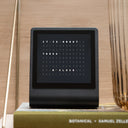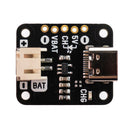Pimoroni Presto
by Pimoroni








Your new RP2350-powered, connected desktop companion! Features a 4" square touchscreen, elegant black aluminium stand and RGB ambient lighting.
Presto is a swish, fully programmable display designed to keep precious digital information close to your fingertips. Make it do anything you want...
📅 Calendar updates? Check.
⛅ Weather reports? Sure!
🐈 Photos of favourite humans or animals? Of course.
🎨 Generative digital art? It would be rude not to.
It features a tasty, full colour 4" square touchscreen IPS display, with all the power of Raspberry Pi's new RP2350 chip behind it. Also behind it is some sweet 7 zone RGB ambient lighting, a piezo speaker for alert boops, an SD card slot for adding storage and a battery connector, so you can power Presto without having it tethered to USB. It also has a built-in RM2 wireless module for 2.4GHz wireless connectivity.
What's in the Starter Kit?
You can buy a Pimoroni Presto on its own (it comes fully assembled, with the screen pre-installed in the stand) or as part of a Starter Kit, which contains a cute little controller and some fun sensors to play with, as well as some extra bits we thought you'd find useful. The Starter Kit contains:
- Pimoroni Presto
- Qw/ST Pad (a tiny I2C game controller)
- Multi-Sensor Stick (an all-in-one super sensor suite for environmental, light and movement sensing)
- 2x Qw/ST cables to connect everything up
- 32GB microSD card
- A USB cable
Features
- Powered by RP2350B (Dual Arm Cortex M33 running at up to 150MHz with 520KB of SRAM)
- 16MB of QSPI flash supporting XiP
- 8MB of PSRAM
- Raspberry Pi RM2 module (CYW43439), supporting IEEE 802.11 b/g/n wireless LAN, and Bluetooth
- 4" square (480 x 480 pixel) IPS LCD screen with capacitive touch overlay
- Rainbow ambient lighting, courtesy of 7x mini SK6812 (Neopixel-compatible) RGB LEDs
- USB-C connector for programming and power
- Piezo speaker
- Reset and boot buttons (the boot button can also be used as a user button)
- MicroSD card slot
- Qw/ST (Qwiic/STEMMA QT) connector for attaching breakouts
- 3 pin debug connector (JST-SH) (on Prestos manufactured after June 2025)
- 2-pin JST-PH connector for adding a battery (3V - 5.5V)
- Pre-installed in a black anodised aluminium stand with rubber feet
- Comes fully-assembled (no soldering required)
- Programmable with C/C++ or MicroPython
- Schematic
Getting Started
To make it as easy as possible to get started making things with Presto, it comes pre-loaded with MicroPython, a snazzy launcher and a selection of examples to inspire you. Check out our Learn guide for a beginner friendly introduction:
You can find the most recent version of the firmware and more examples below:
There's also a boilerplate project for if you'd prefer to program your Presto with C++.
Connecting Breakouts
Presto has a Qw/ST (AKA Qwiic/STEMMA QT) connector, so you can connect up Qw/ST breakouts easily using a JST-SH to JST-SH cable.
Notes
- Measurements: 110mm x 92mm x 80mm (H x W x D, approx)
- Presto has no battery charging hardware onboard - this is so you can use either alkaline or LiPo batteries safely. You'll need to charge up your LiPo battery with a separate battery charger - we like LiPo Amigo. LiPo Amigo Pro can charge your battery and power Presto at the same time (note that you'll also need one of these JST-PH cables to plug in your device).
- The battery connector can be used to power Presto with batteries that provide between 3V and 5.5V. At the lower end of that voltage range, you'll start to see dimming of the backlight and less vibrant colours. We'd suggest using a chunky LiPo, or a 3x AA alkaline battery pack - check out the extras for some options.
About RP2350
The RP2350 chip is the Double Quarter Pounder & Fries to the RP2040's Double Cheeseburger and can have one or more RISC-V burgers instead of either of the M33 ARMs, to stretch the metaphor.
In addition to the modern M33 ARM cores, there are sides of: more PIO capability, a variety of low power states for sipping electrons, a whole security system and some sprinklings of specialist digital video circuits to offload DVI/HDMI output.
You can expect a tasty boost in performance - our "real world" MicroPython tests are running up to 2x faster compared to RP2040, and floating point number crunching in C/C++ is up to 20x faster. The extra on-chip RAM will make a big difference when performing memory intensive operations (such as working with higher resolution displays) and even more can be added thanks to external PSRAM support.
RP2350 comes in two flavours - A (standard) and B (all the pins). The B chip has a stonking 48 usable GPIO pins, including 8 ADCs and 24 PWMs, and features on some of our new products.
-
Presto Only
PIM72530% off!£40.25was £57.50 -
Starter Kit
PIM76530% off!£57.75was £82.50
LiPo battery
A rechargeable LiPo pack and our LiPo Amigo charger
-
Lithium Ion Battery Pack+ £8.25
-
 LiPo Amigo (LiPo/LiIon Battery Charger)+ £3.25
LiPo Amigo (LiPo/LiIon Battery Charger)+ £3.25
Shop with confidence – we've been serving the hobbyist electronics, Maker, and retro gaming communities since 2012.
- Satisfaction or refund guarantee
- Worldwide shipping via mail or courier
- 57,000+ customer reviews
- Secure website and payments

